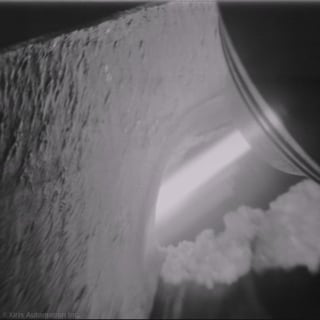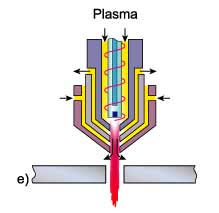Using a Xiris high dynamic range Weld Camera to see the detail of a Plasma Cutting or Welding process can provide more information for the operator than was ever possible before. With a huge dynamic range of imaging possible, the camera can acquire a clear view of the super bright plasma arc as well as its immediate background. Details, such as the smoothness of the cutting line and the form of the melted material kerf left after the plasma, are easily observed. With this type of image available from a Xiris Weld Camera, operators are able to better control the plasma process with images generated such as the following:

View of the Plasma Arc, Cutting line and Melted Kerf
In addition to providing clearer details, the Weld Camera can also be used as a process research tool to study the plasma torch to determine how well the gas and electric charges are being transmitted from the electrode and nozzle to the workpiece.
To understand how the Xiris XVC-1000 Weld Camera can be used as a process research tool, first some background of the basic principle of how a plasma torch is used to superheat gas:
A plasma arc begins by initiating a high frequency electric charge in an electrode, negative in charge relative to the workpiece to be cut or welded. The electrode itself sits inside a head through which a mixture of gasses is injected around the electrode and out through a nozzle. The gas used is usually a mixture of common gasses such as oxygen, nitrogen and other trace elements. The gas becomes ionized and turns into plasma as it travels over the highly charged electrode, creating a conductive path between the electrode and the workpiece. This ionization allows an electric arc to jump between the electrode and workpiece, much like a bolt of lightning. The gas comes out of the orifice in a high speed vortex, swelling as it exits the orifice, which allows it to be very well controlled so that the flow can be tightly focused or confined on a particular spot. Once focused, the plasma melts or erodes the workpiece to perform the cutting or welding process of the material.
 The Plasma Process
The Plasma Process
(courtesy of www.twi-global.com)
When using the Xiris XVC-1000 weld camera, Area of Interest (AOI) imaging can be used to view only a portion of the screen, but at much higher frame rates. If the frame rate gets high enough, it is possible to see some of the flow of the electric arc and plasma/gas to and from the substrate. Such imaging capability can provide information about: how well the Plasma arc is controlled into a beam, the rate at which the gas is moving in a vortex as it exits the nozzle, the forming of the plasma, and other parameters.
Conclusion
The Xiris XVC Weld Camera is a powerful tool to image Plasma welding and cutting applications. Beyond monitoring the Plasma process for quality control, the XVC-1000 can also provide valuable process details; key for research into better Plasma cutting and welding techniques.




.png)

